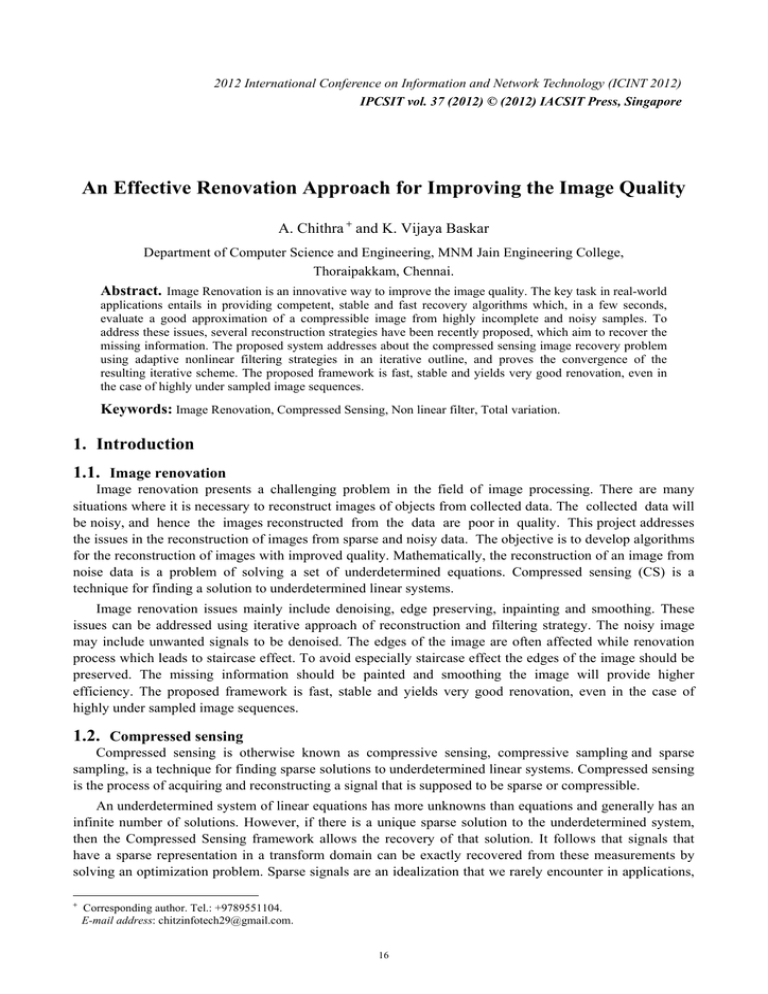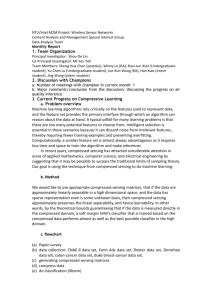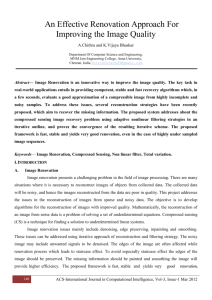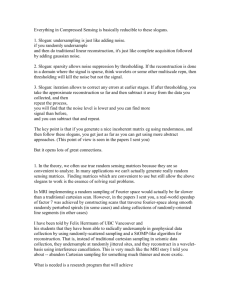An Effective Renovation Approach for Improving the Image Quality A. Chithra Abstract.
advertisement

2012 International Conference on Information and Network Technology (ICINT 2012)
IPCSIT vol. 37 (2012) © (2012) IACSIT Press, Singapore
An Effective Renovation Approach for Improving the Image Quality
A. Chithra + and K. Vijaya Baskar
Department of Computer Science and Engineering, MNM Jain Engineering College,
Thoraipakkam, Chennai.
Abstract. Image Renovation is an innovative way to improve the image quality. The key task in real-world
applications entails in providing competent, stable and fast recovery algorithms which, in a few seconds,
evaluate a good approximation of a compressible image from highly incomplete and noisy samples. To
address these issues, several reconstruction strategies have been recently proposed, which aim to recover the
missing information. The proposed system addresses about the compressed sensing image recovery problem
using adaptive nonlinear filtering strategies in an iterative outline, and proves the convergence of the
resulting iterative scheme. The proposed framework is fast, stable and yields very good renovation, even in
the case of highly under sampled image sequences.
Keywords: Image Renovation, Compressed Sensing, Non linear filter, Total variation.
1. Introduction
1.1. Image renovation
Image renovation presents a challenging problem in the field of image processing. There are many
situations where it is necessary to reconstruct images of objects from collected data. The collected data will
be noisy, and hence the images reconstructed from the data are poor in quality. This project addresses
the issues in the reconstruction of images from sparse and noisy data. The objective is to develop algorithms
for the reconstruction of images with improved quality. Mathematically, the reconstruction of an image from
noise data is a problem of solving a set of underdetermined equations. Compressed sensing (CS) is a
technique for finding a solution to underdetermined linear systems.
Image renovation issues mainly include denoising, edge preserving, inpainting and smoothing. These
issues can be addressed using iterative approach of reconstruction and filtering strategy. The noisy image
may include unwanted signals to be denoised. The edges of the image are often affected while renovation
process which leads to staircase effect. To avoid especially staircase effect the edges of the image should be
preserved. The missing information should be painted and smoothing the image will provide higher
efficiency. The proposed framework is fast, stable and yields very good renovation, even in the case of
highly under sampled image sequences.
1.2. Compressed sensing
Compressed sensing is otherwise known as compressive sensing, compressive sampling and sparse
sampling, is a technique for finding sparse solutions to underdetermined linear systems. Compressed sensing
is the process of acquiring and reconstructing a signal that is supposed to be sparse or compressible.
An underdetermined system of linear equations has more unknowns than equations and generally has an
infinite number of solutions. However, if there is a unique sparse solution to the underdetermined system,
then the Compressed Sensing framework allows the recovery of that solution. It follows that signals that
have a sparse representation in a transform domain can be exactly recovered from these measurements by
solving an optimization problem. Sparse signals are an idealization that we rarely encounter in applications,
+
Corresponding author. Tel.: +9789551104.
E-mail address: chitzinfotech29@gmail.com.
16
but real signals are quite often compressible with respect to an orthogonal basis. This means that, if
expressed in that basis, their coefficients exhibit exponential decay when sorted by magnitude. As a
consequence, compressible signals are well approximated by sparse signals and the compressed sensing
paradigm guarantees that from linear measurements it can obtain a reconstruction with an error comparable
to that of the best possible terms approximation within the sparsifying basis.
2. Reconstruction Approach
2.1. Methodology
A new denoising method is developed based on ROF model [2], [4] in combination with a vector field
smoothing algorithm. First, the input image is decomposed into a bounded variation component standing for
geometrical and an oscillating component standing for textured structure and noise. In which, the
Chambolle’s projection algorithm [1] is adopted to perform numerical computation. Next, the oscillating
component is smoothed by using an indirect method derived from the vector field smoothing. Then, the sum
of the bounded variation component and the smoothed oscillating component is calculated to obtain the
smoothed result.
The proposed system can be seen as a modification and improvement of the traditional edge-preserving
regularization where the bounded variation components are used as the processed results while regardless the
oscillating components. Such an approach allows preserving fine structures. The comparison shows that the
new smooth method outperforms the ROF, as well as the standard median filters.
3. System Architecture
Fig. 1: System Architecture
3.1. Detailed description
3.1.1 Parameter initialization:
Signal. The signal object is to specify the initial value of any signal. The initialized signal value will be
consistent. The given signal can be associated with at most the signal object.
It’s Fourier Transform. It decomposes a signal into its Constituent frequency. It transforms signal
into its constituent frequencies. It’s mainly used to compress the image.
Gradient Field. It is mainly for shading recovery problem. They are switched on and off 1000s of time
in the signal image. The switching creates forces and gives rise to unwanted signals. It is used for shadow
removal and lightness [8].
3.2. Iterative reconstruction
17
In various information processing tasks obtaining regularized versions of a noisy or corrupted image data
is often a prerequisite for successful use of classical image analysis algorithms. Image restoration and
decomposition methods need to be robust if they are to be useful in practice. In particular, this property has
to be verified in engineering and scientific applications. By robustness, we mean that the performance of an
algorithm should not be affected significantly by small deviations from the assumed model. In image
processing, total variation (TV) [3] is a powerful tool to increase robustness.
The proposed system provides a new iterative [5] approach to perform minimization via the well-known
Chambolle's algorithm [1]. The implementation is then more straightforward than the half-quadratic
algorithm. The behaviour of image decomposition methods is also a challenging problem, which is closely
related to anisotropic diffusion.
EROF (Extended ROF) leads to an anisotropic decomposition [7] close to edges improving the
robustness. It allows to respect desired geometric properties during the restoration, and to control more
precisely the regularization process. It also discusses why compression algorithms can be an objective
method to evaluate the image decomposition quality. This algorithm exploits a dual formulation of the
minimization problem, and uses a fixed point iteration to find a solution of the dual formulation. Chambolle
proves that these iterations are contractant, and thus converge to a solution with linear speed.
Fig. 2: Process of Chambolle’s algorithm
3.3. Chambolle also exposes two important extensions of this algorithm
•
•
The regularization parameter lambda can be updated during the iterations in order to solve the L2
constrained problem (instead of Lagrangian regularization). This is very useful if you know the level
of noise that is pertubating your measurements.
A slight modification of the iterations can be used to solve any inverse problem y=A x if the operator
A involved is an orthogonal projector, meaning that A A^*=Identity (the row of your operator are
mutually orthogonal). These two features makes this algorithm useful to solve compressed sensing
with random orthogonal (e.g. Fourier) measurements using TV regularization [3].
3.4. Apply filter and display
The Filter Approach uses new adaptive median filters .It does the following operations: [8], [9], [2], and
[7] Classifies noise.
Act by shifting a point wide window along the directions of the input image and replacing the central
value with the median of the ordered set inside the window.
This process involves the convergence property of the output image. By iteratively applying the new
median formula pixel by pixel until convergence, we obtain the result.
4. New Adaptive Median Filter
18
Median filters [6] are well known nonlinear filters used in image denoising problems. They act by
shifting a (2l + 1) * (2l + 1) point wide window along the two directions of the input image and replacing the
central value with the median of the ordered set inside the window. These filters enjoy the following
minimum property: the output of weighted median filter acting on the set {U i ,i = 1,2,..., (2l + 1) * (2l + 1)}
can be defined as the value of minimizing,
L(U ) = ∑ Wi | u − ui |
−i
In [20] the authors have shown that the action of the iterated median filter can be obtained using in a
single iteration of its recursive version. We have, therefore, applied the following recursive new median
filter,
.new
U opt
= median = U 1new ,..., U 4newU 5 ,..., U 8 P0 , P1 ,..., P8 }
5. Experiment
We show some examples of images processed with this algorithm .In the examples of Fig. 3 to which a
noise of standard deviation with 9% has been added. The original is a 256 × 256 square image with values
ranging from 0 to 255. The CPU time for computing the reconstructed images is in both cases approximately
0.9 seconds, on a Intel Pentium dual processor with 2 Mb of cache. The criterion for stopping the iteration
just consists in checking that the maximum variation between pn i, j and pn+1 i, j is less than 1/100. Notice
that this algorithm can very easily be parallelized.
Fig. 3: Iteration 1
Fig. 4: Iteration 1+n
Fig. 5: Final output – Reconstructed Image
19
6. Conclusion
The proposed system is a powerful algorithm by combining compressed sensing approach and adaptive
non linear filter techniques that can be used in a variety of applications like prediction, error concealment,
inpainting etc. Further, we believe that the algorithm presented in this paper for compressed sensing can be
extended to other interesting imaging and vision applications.
7. References
[1] Yongping Zhang, Member IEEE, Zhongkun He, Rina Su, Shaojing Fan (2010) , “An Approach to Image Denoising
Based on Variational Decomposition in Combination with Vector Field Filter” .
[2] Leonid I. Rudin 1, Stanley Osher and Emad Fatemi (2005) ‘Nonlinear total variation based noise removal
algorithms’.
[3] Ivan Selesnick Ilker Bayram (2006) ‘Total Variation Filtering’, The Connexions Project and licensed under the
Creative Commons Attribution License.
[4] Donald Goldfarb and Wotao Yin (2007) ‘Parametric maximum flow algorithms for Fast totals variation
minimization’ Department of Industrial Engineering and operations Research, Columbia University.
[5] J. Bioucas-Dias and M. Figueiredo, ‘A new TwIST: Two step iterative shrinkage-thresholding algorithms for image
restoration’, IEEE Trans. Image Process., vol. 16, no. 12, pp. 2992–3004, Dec. 2007.
[6] Y. Li and S. Osher, “A new median formula with applications to PDE based denosing,” Commun. Math. Sci. , vol.
7, no. 3, pp. 741–753, 2009
[7] Laura B. Montefusco, Damiana Lazzaro, and Serena Papi ‘Fast Sparse Image Reconstruction Using Adaptive
Nonlinear Filtering’ , IEEE Transactions on Image Processing , Vol.20 , No.2, February 2011.
[8] Graham D. Finlayson, Member, IEEE, David Connah, and Mark S. Drew, ‘Lookup-Table-Based Gradient Field
Reconstruction’, IEEE Transactions on Image Processing , Vol.20 , No.10, October 2011.
[9] Chambolle, “An algorithm for total variation minimization and applications,” J. Math. Imaging Vis. 20, 2004.
20






